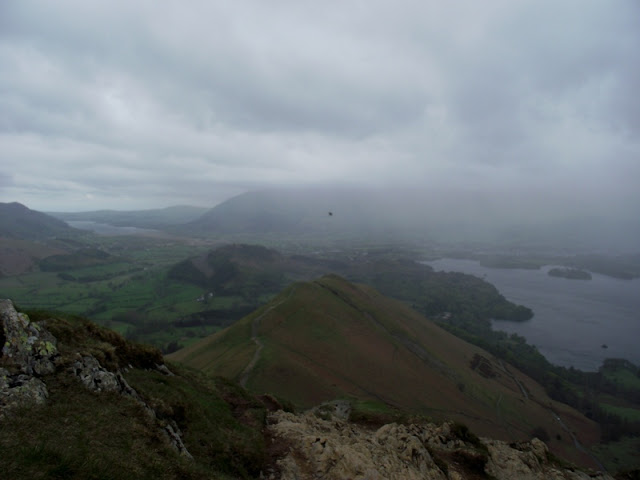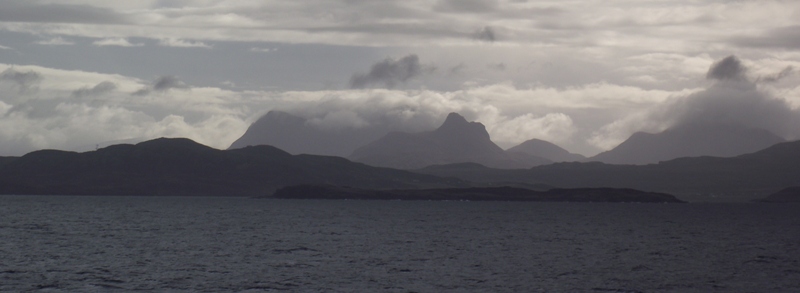As I have travelled, the ferries have gotten progressively
bigger, and the journeys (if you discount the small isles venture) have gotten
longer. It’s nearly three hours from Stornoway to Ullapool across the water.
Coming into Loch Broom, the sea loch that the streets of Ullapool were ploughed
beside, there were some impressive silhouettes of curiously curved peaks on
which details were slowly filled in, and passed, as we moved forwards.
In Ullapool, I had someone waiting for me at the ferry
terminal, a distant MacKenzie cousin in a brimmed hat and with a
blonde dog. I hadn’t met her before, though she knew my grandparents and great
aunt quite well from their trips to Scotland. She greeted me with a hug.
The land around here is MacKenzie country, the Seaforth
MacKenzies of the Highlands. Many of the paddocks on our farm in New Zealand,
and even the farm itself, take their names from this ancestral area of ours. My
great grandfather was born here, in a small house on the waters of Little Loch
Broom just a little further south-westish and running parallel to the
bigger Broom.
 |
| View down onto Ullapool and the mouth of Loch Broom |
My cousin however-so-many-times-removed has a Bed and
Breakfast, closed at the moment, and home to several dogs, hens, and some feral
cats in the process of being befriended – one named Possum, to her amusement, as my grandfather quite rightly hated possums. The cat, however, is
absolutely beautiful. Her partner is an artist, and the walls are covered in pictures
of animals done by him – a portrait of a patterned cat, a stag stepping
forwards from a forest, a fox fruitlessly chasing a song bird through the snow.
I was given a room that, she thought, my grandparents had slept in. It was a
delight both for that and for having my own double bed and adjoining private
bathroom. The window looked over the loch which, that day, was glowing with
the sun that had decided to come out. “If there’s enough blue to make a pair of
sailor’s trousers,” she said.
On the edge of the loch and with those wonderful Highland
hills on either side, Ullapool is beautiful. We drove up above it, then out
along it beside model farms and salmon hatcheries and the heathered hills as a
manner of evidence of the Clearances – make way for farmland, said the English,
and get rid of those awful people.
At the petrol station we saw a bird of prey above a hill. It
looked too small to be a buzzard, and the head looked paler than a buzzard’s is
meant to be. Sadly I didn’t get a chance to match its silhouette with the one the chap in
the sea eagle exhibition gave me, as it didn't turn at the right angle,
but they say there have been a pair nesting around the area. Driving out, we stopped at a
tree of American extraction that I only remember the local’s proverbial name
for – the punch tree. When you punch it, the bark is soft. “Guess who else has
punched here,” she said.
 |
| View beside Destitution Road |
We took Destitution Road, with its stretching
golden hills and the snowy mountains at either end. It’s been used in car
advertisements the world around, she told me. We passed a deep gorge on a fault
line, stopped at a little shop with a stream and bird feeders – she had hoped
to show me red squirrels here, but the population had drastically dropped, and
there were suspicions of a mink, an introduced little demon, having something
to do with it. We, ahem, passed by the house of Tim Rice’s wife, which had over
the front door the weathered stag’s head of the MacKenzie crest, and which has
in its garden a yew tree whose age goes beyond reckoning. At least 1,000 years,
they say, if not older.
 |
| Coming towards Kildonan House |
The road is narrow and winds through the scenery, looking
down over Little Loch Broom. We stopped at a gateway, padlocked to keep cars
off the access road. Ealier, it was a matter of picking one's way carefully across soggy ground and probably still
winding up with wet feet when you reached the peak of the little hill. It looks over the loch, its beach of smooth stones looking like a crescent of grey
sand, and the foundations of stone buildings on the land and one still standing – a
shop, once – in view. Going on a little further, Kildonan House begins to
appear. It’s closer, but the shape of the land brings first the planted trees,
then the roof, and then the rest, into sight. It’s a small white house, boarded
up and empty at the moment, and with an overgrown and muddy garden, and,
despite the other buildings, it has the bay to itself. My great grandfather was
very young when his family left. Times were difficult, and though they were by
no means in desperate straits, it seemed that there would be opportunities
overseas.
 |
| Kildonan House: where some of it began |
 |
| The old shop, the only stone building still in tact. It has a pretty old fireplace inside. |
Perhaps the beach at Little Loch Broom explains my love of
stony beaches. We sat there for a while, while I listened to legends and
stories more immediate, and looked at the water and mountains and hills. We
unsettled a small herd of deer who watched us for some time from the horizon,
waiting for us to leave. They gave up first.
 |
| Eff off, will you? |
The next day – after I slept in quite happily, and had black
pudding for breakfast – did not give us the same kind of weather as we drove the other way, out towards Sutherland. The Clearances were very bad in this part of Scotland. I hadn't realised how poorly the Highlanders had been treated. I don't know my history. I want to. I will.
It was quite
overcast and then quite rainy, and I missed out, I’m told, on much of the
scenery. I did see the closer hills, however, and peaks in moments when the
veils shifted for a moment, and I saw snow. The drive, with all three of us this time, served as a sight-seeing, oddjob-investigating, pie-and-sausage-gathering expedition. We stopped to look, heigh ho the wind and the rain, at the ruins of Ardvwreck Castle, which had particular ancestral significance for my cousin. In the weather it had a particularly gothic-Romantic air. I could imagine the man in grey, a kindly ghost who speaks only Gaelic, escorting people across the grass.
 |
I cannot remember her name, but she's beautiful and sometimes dangerous,
a little of a femme fatale |
It was after, as we drove upwards, that the snow began, thrown like
light rain in the wind against the wind sheild, where the crystals melted and
slid down. It was white everywhere. And suddenly, as we dropped from the mountains,
it was gone and instead there was only rain.
I'll return to Ullapool.


























































